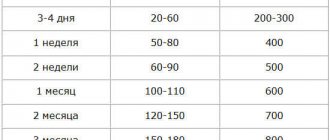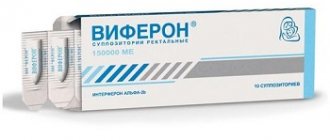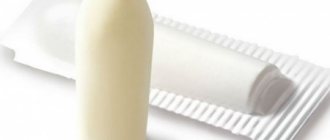How to put a suppository rectally on a baby for constipation
Anti-constipation suppositories for newborns should be chosen that are safe and have an immediate effect. They help to quickly empty the intestines, but they should not be used frequently. Parents should definitely consult a specialist to determine the cause of constipation.
Causes of constipation in children
The gastrointestinal tract of children in the first days of life undergoes adaptation for several weeks, and sometimes months. We have to adapt to the new food system. Any, even minor factors, can lead to disruptions in intestinal function. Often, constipation in a small child develops due to improper absorption of water, for example, lack of fluid or improper dilution of the formula.
The following unfavorable factors can cause constipation in children under one year of age:
- artificial feeding or switching from breast milk to formula;
- period of teething;
- infectious and chronic diseases;
- side effects on medications;
- improper diet;
- insufficient drinking regime;
- inactivity;
- disruption of beneficial intestinal flora;
- lactose deficiency;
- abnormalities in the structure of any part of the intestine.
Whether suppositories can be used to ease stool in young children should be decided by the doctor. But you shouldn't use them constantly. They do not cure, but are only considered emergency aid in the absence of stool for more than two days. Uncontrolled use of laxatives can lead to complications such as enterocolitis, intestinal obstruction, and dysbiosis.
Cases of prescribing suppositories
In the event that a newborn does not have stool for several days, the consistency and density of stool changes, the frequency of bowel movements is disrupted, and difficulties appear in bowel movements, constipation is diagnosed.
Constant constipation can lead to the development of cracks in the anus, toxins begin to be absorbed into the blood, poisoning the entire body, immunity decreases, and the flow of nutrients into the body, including vitamins and microelements, is disrupted. Rarely, but occurs, intestinal prolapse.
You will definitely need to visit a specialist.
Often it is enough just to change the diet, and the problem disappears (it is useful to introduce beets, prunes into the diet of a nursing mother, or change the mixture to another brand). Rectal suppositories may be prescribed as an emergency aid. They activate intestinal motility, soften the contents and promote painless cleansing of the cavity.
Children in the first months of life can have stools up to five times a day, and as they approach a year, the frequency of stools decreases to twice a day. The amount of stool depends on what feeding the baby is on. Artificial babies have bowel movements less often than babies who are breastfed.
You can tell if a baby is constipated by the following signs:
- the baby is restless, capricious, whiny, sleeps poorly;
- refuses milk, regurgitates frequently;
- the child often strains and groans;
- The lower abdomen feels hard to the touch.
If at least one of the listed symptoms appears, you need to provide the child with ambulance as soon as possible, give a microenema or light a candle.
If there are no such symptoms, but the baby has not had hard stool for several days, do not rush to light a candle. You can get by with a simple massage, gymnastics, or changing your diet.
Rules of application
You should not often use suppositories for newborns, as they are addictive and the intestines will stop contracting on their own.
The procedure for introducing a suppository is best done in the first half of the day, 25 minutes after feeding. If you insert a suppository at the same time for several days in a row, the intestines can begin to work on their own.
It is better to lay the baby on his left side and bend his knees. The candle is inserted with the tapered end. You can pre-coat the anus with Vaseline or baby cream. If the candle was stored in the refrigerator, then first you need to hold it a little in your hand. Children, feeling a foreign body inside, begin to push. Therefore, after the suppository is inserted, you need to slightly squeeze the buttocks.
It is recommended to administer one suppository to children under three months of age for no longer than three days in a row. For children over three months old, the duration of treatment can be extended to a week, but only in extreme cases.
Contraindications to the use of rectal suppositories are rectal fissures, tumors, and allergic reactions to the constituent components of the drugs. Do not use for appendicitis and rectal bleeding.
There are two main groups of suppositories for constipation in newborns: glycerin and gas-forming. The action of the first type of suppositories is aimed at softening stool, as a result of which they are freely excreted. Gas-forming suppositories serve as auxiliary therapy and only increase the urge to empty the bowel.
For children, glycerin suppositories are considered the best option. They do not cause pain or discomfort, have a softening effect and give results faster.
Types of drugs
There are no special suppositories for constipation for infants, but there are approved medications that can be used if a problem occurs. List of the safest and most effective candles.
Glycerin suppositories are considered the most popular and safest. The instructions suggest their use from the first days of life. Glycerin suppositories soften stool and promote their natural removal.
The action occurs within 30 minutes. One suppository contains 1.24 glycerol. If a Glycerin suppository is used for newborns, it is recommended to divide the suppository into three more parts.
Do not use it for more than three days in a row.
Glycerin suppositories are most often prescribed for newborns. The active ingredient of the drug is not absorbed into the intestinal walls, so there is no systemic effect on the body. But, like any other laxatives, Glycerin suppositories do not cure, but only relieve symptoms.
Another drug is Glycelax, which has a laxative effect. It contains 0.75 g of the active ingredient glycerol.
The components irritate the intestinal walls, stimulate peristalsis and soften stool. As a result, natural bowel movement occurs.
The act of defecation usually occurs within the first 15 minutes after the administration of the suppository, but can occur after 1.5 hours.
Glycelax children's suppositories do not have a negative effect on other organs, since the components do not penetrate the systemic bloodstream. Continuous treatment is allowed for no longer than 5–7 days. For children under one month old, you can divide the candle into two or three parts. If the divided dosage does not lead to the desired result, after two hours you can re-administer the drug in a larger dosage.
Source: https://cross-bones.ru/kak-postavit-svechku-grudnichku-rektalno-ot-zapora/
Helpful tips during treatment
Before administering the drug to children, it is advisable to empty their intestines. In reality, a baby cannot do such an important thing when ordered.
Therefore, parents need to be prepared for double the consumption of suppositories. When the rectum is irritated by a suppository, defecation often occurs instantly. All that remains is to wash the baby and start all over again.
If the baby refuses to lie down after the drug is administered, then you can carry him in your arms so that he is in a horizontal position.
A difficult baby will still have to be persuaded somehow. For example, read a book or come up with some kind of game during this time. To facilitate administration, do not use oils or creams (even for children) .
Oil-based products make absorption difficult, but promote early release of the suppository from the anus.
For this purpose, use ordinary warm water, moistening the anus area with it. Rectal suppositories make treatment easier for young children, especially if it is not possible to give them medication orally. Therefore, parents need to learn how to use the medicine in this form quickly and painlessly for the baby.
How to light a candle for a baby
Infants have a weak immune system. That is why they suffer from negative external influences much more often than adults. To quickly and effectively relieve some symptoms, it is recommended to insert special suppositories rectally.
Thanks to this, the necessary components are absorbed into the blood and give a positive effect much faster. The form of the drug is very popular in the treatment of young children. The therapist prescribes them to the child only after a detailed examination. The method is convenient, because in the first year of life, children cannot yet swallow pills on their own.
In turn, not all parents will be able to administer the drug intramuscularly. This requires experience.
To light a candle for a baby, you need to stock up on the following manipulation tools:
- Medicinal suppositories (only those drugs prescribed by a doctor can be used).
- Vaseline or baby cream. They are necessary for introducing the drug into the anus without damage.
Main contraindications
The anti-constipation remedy acts locally and therefore has no contraindications. A composition with paracetamol to lower body temperature can only be used if the child is already one year old.
Do not use other tablets to reduce fever at the same time. Paracetamol can cause allergies, which manifest as redness of the skin.
Cases of malfunction of the heart and gastrointestinal tract have also been recorded.
Candles should not be used if the baby has previously been diagnosed with kidney or liver disease. They are also dangerous to use for inflammation in the rectum. In this case, the likelihood of worsening the overall clinical picture increases.
With the help of rectal suppositories it will be possible to normalize body temperature. However, this method cannot be used to eliminate pain and spasms.
A paracetamol suppository can be administered to a newborn baby only once. It will effectively reduce body temperature. After this, you should seek medical help. The pediatrician will be able to select a medicine that will fully correspond to the individual characteristics of the child’s body.
An overdose is dangerous for a child. That is why it must be avoided. Otherwise, the risk of developing liver and kidney problems increases.
Suppositories are used only in small quantities if the course of treatment also includes antibiotics. In this case, the dose is selected separately by the attending physician.
Source: https://floragaz.ru/zdorovye/kak-postavit-svechku-grudnichku
Is it possible to insert 2 products rectally at the same time?
The need to administer two suppositories at once occurs in two cases:
- Increasing the dose of the drug. You can insert two pieces at once, but only for children over one year old. Infants need a break of 1 hour.
- The use of two types of drugs in rectal form.
It is not recommended to insert two suppositories at once. First, one drug is administered, and after half an hour or an hour, another.
But before this, you need to consult a pediatrician. Medicines should complement each other's effects, not cancel each other out.
How to insert a suppository into the baby's rectum correctly
Here are the main reasons why bowel movements occur in infants:
- a sharp transition from breastfeeding to artificial feeding (a sudden change of milk formula from one brand to another, and even from one type of formula to another, carried out with age);
- violation of the diet of a nursing mother. Very often, the cause of constipation in infants is the mother’s poor diet;
- lack of breast milk, as a result of which so-called starvation constipation appears, when the food received is completely absorbed, and the child simply has nothing to go to the toilet with. To exclude this point, monitor your child’s weekly weight gain, it should be at least 130 grams;
- lack of muscle tone in the intestines. To exclude this point, an examination by a neurologist is necessary;
- violation of defecation can be caused by lactase deficiency;
- infectious or colds. If a child has a high temperature, problems with bowel movements may occur;
- lack of fluid. A bottle-fed child must receive the required amount of water (each age has its own norm). Likewise, when introducing complementary foods, he must drink a sufficient amount of liquid;
- if complementary feeding was introduced too early, the child may experience constipation, because the amount of mother’s milk or formula will decrease, and the intestines are not yet functionally ready to consume “other” food;
- Allergy to cow protein is a common cause of constipation in formula-fed children; this condition occurs especially often in children who are fed unadapted formulas and who are early started preparing porridge with cow’s or goat’s milk.
How to insert candles correctly
Wondering where to put the medicine? Directly through the anus into the rectum. To do everything right, you need to follow a simple sequence
It is important not to resort to self-medication. The drug must be prescribed or approved by a doctor
Hands should be washed before manipulation. This is the key to limiting access of additional bacteria to a vulnerable organ. Unprotected fingers with long nails can cause injury to the mucous membrane of the inflamed intestinal tract. It is recommended to wear thin medical gloves.
Before administering the suppository, you must read the instructions so as not to make a mistake with the dosage and know all the nuances of the action of the main substance. Never exceed the dose prescribed by your doctor. If you intend to use half of the drug, it is better to divide the candle lengthwise rather than crosswise.
The medication can be placed in two positions:
Lying on your side (preferably left), you should lift your upper buttock and insert the drug into the anus, pre-lubricated with Vaseline.
To make things easier, you need to bend your right leg, pull it towards your chest, and relax your anus as much as possible. The suppository is quickly pushed through the sphincter with the index finger (depth 2-2.5 cm).
Squeezing your buttocks, you need to lie down for a few minutes. Babies are administered using the little finger (depth approximately 1.5 cm).
Standing, leaning forward, spread the buttocks with one hand, and insert the candle inside with the other. After finishing the procedure, it is better to lie down for 30 minutes so that the medicine works faster and does not leak. The stages are shown in the photo in the article.
How to insert suppositories rectally
Before using rectal suppositories, it is better to do an enema with cold water: this will prevent infection. The tablet should be cool before administration. It will be easier to enter it this way.
Suppositories for hemorrhoids, such as Relief, Genferon, Proctosedyl, should be stored in the refrigerator. Before administering the suppository, you should wash your hands with soap. The introduction can be carried out in different positions.
For example, standing (you need to lean forward slightly), lying down with your knees bent, legs raised, etc.
Whatever position you choose, you need to completely relax your gluteal muscles. Otherwise you will experience pain. You cannot forcefully insert the drug, as this can injure the muscles of the anus. Before inserting the suppository, the anus should be lubricated with oil, cream or Vaseline. This will make insertion easier.
All this must be done quickly, otherwise the candle may melt in your hands. We take the drug in one hand, with the other hand we spread the gluteal muscles. Suppositories for hemorrhoids are inserted with the sharp end into the anus, the buttocks are moved together. This will prevent the medicine from leaking out. Rectal suppositories for hemorrhoids should be inserted after visiting the toilet.
After the candle is inserted, you need to lie quietly for half an hour.
It is better for children to insert them during sleep, otherwise they may refuse this procedure. Suppositories for hemorrhoids or any other for children must be heated before use. It is recommended to administer the medicine to the child when he lies on his side, with his legs tucked towards his stomach.
This will help reduce discomfort. Suppositories for hemorrhoids must be placed after the child has gone to the toilet, otherwise they will come out during defecation. The drug should be inserted into the child with the sharp end, after spreading the buttocks with your hands.
For easier insertion, the anus needs to be lubricated.
Features of administering suppositories at different ages
Each age has its own psychological characteristics. Infants cry and tense up when there is a sudden change in the situation and a change in sensations.
Here, the main task of parents is to make the process of introducing a rectal agent smooth and as less noticeable as possible.
Children from one to three years old are ready to endure if they receive a reward for it.
Patients aged three years and older need to be explained why this is necessary. Without appropriate ideological indoctrination, little conservatives will not allow themselves to light a candle.
Teenagers are the hardest to persuade to do this. There is only one way out - to allow the suppository to be inserted yourself.
How to administer a suppository to a baby up to one year old
The following preparation is required before the procedure:
- Prepare a changing table or other flat surface (bed) by covering it with a clean diaper.
- Place a rattle or any favorite toy, a package of medication, and scissors nearby.
- Wash and dry your hands.
- Wash the child or simply wipe the perineum with a damp cloth.
The medicine in the form of suppositories should be stored in the refrigerator, taken out 30-40 minutes before use to warm up.
Your hands should be pleasantly cool, but not hot, so that the candle does not start to melt in them.
The suppository is cut out of the cellular packaging with scissors, pinching the thick end between two fingers of the right hand, pointing the sharp end forward.
At this time, the baby should already be lying on the prepared surface with a toy in his hands.
The injection procedure for infants can be carried out in three positions :
- Lying on your back. With the left hand they take the heels, slowly lifting them up so that the pelvis is raised above the surface. The knees are carefully pressed to the tummy, quickly inserted, then squeezing the buttocks tightly for a minute. After this, it is advisable to place the baby on his tummy for 10-15 minutes.
- Lying on your stomach. Many babies like to sleep or stay awake on their tummy with their bottom raised. This is a very comfortable position for insertion. The child is relaxed, the mother will only have to carefully administer the medicine and leave him alone, stroking his butt.
- Lying on your left side. In this position, you need to pull the baby’s knees to the chest, spread the buttocks with two fingers of your left hand and, with a precise movement, point the candle with the sharp end forward, into the anus. Then squeeze your buttocks tightly for 30 seconds.
After manipulation, place on the tummy for 10-15 minutes.
The suppository in the rectum melts and dissolves very quickly, but the child still needs to be kept in a horizontal position for some time.
For a baby over a year old
Preparation for the procedure for older children is similar to the previous one. As an addition to the toy, you can include your favorite cartoons. At this age, the following insertion positions are recommended:
- lying on your stomach, placing a pillow or cushion under the pelvic area. Before insertion, you need to spread the buttocks, insert a suppository, and remove the pillow. You can promise your baby something nice if he lies quietly for 15 minutes.
- Lying on your left side. The suppository can be administered in the same way as for infants up to one year old.
An hour before the procedure, you can give your baby grated apples or other fruit puree to encourage bowel movements. This works especially well in the morning, on an empty stomach.
For children over three years old, we can recommend a squatting position for insertion, with legs spread wide apart. This position is uncomfortable for parents, but many children like it. Then you will still have to lie on your stomach so that the candle does not fall out.
What to do with teenagers
In adolescence, there is also a need to use drugs in rectal form. For example, during a stomach infection or sensitive stomach mucosa. Teenagers during illness show extreme obstinacy, refusing medications in this form.
Parents can only ask a medical professional to explain the need for treatment and show how this manipulation can be done independently.
To do this correctly, you can invite your teenager to watch this video:
Rules for using candles
Regardless of what ailment (fever, constipation) suppositories are used to combat, it is important to follow the rules. Compliance with the basic requirements for the use of candles will help make the procedure more comfortable, safer and more effective
- Candles must be stored in the refrigerator, otherwise they will melt and cannot be used.
- You need to remove the suppository from the packaging right before the procedure. You should not do this in advance, because germs may get on it.
- Hands must be washed with soap and dry before the procedure.
- It is recommended to use suppositories after consultation with a doctor.
There are also several recommendations for treatment with rectal suppositories, depending on their purpose.










